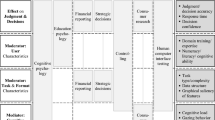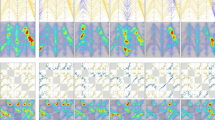Abstract
While the situation space consists of facts about what is currently happening, the decision space consists of analytical information that supports comparing the relative desirability of one decision option versus another. We have focused on new approaches to display decision space information that aids cognition and confidence. As a result of our earlier empirical work, we have developed a set of principles for visualizing decision space information. This paper describes those principles and illustrates their use.
Chapter PDF
Similar content being viewed by others
Keywords
References
Baddeley, A.: The magical number seven: Still magic after all these years? Psychological Review 101(2), 353–356 (1994)
Chandrasekaran, B.: From optimal to robust COAs: Challenges in providing integrated decision support for simulation-based COA planning, Laboratory for AI Research. The Ohio State University (2005)
Drury, J.L., Klein, G.L., Musman, S., et al.: Requirements for data mining the decision space. In: Proc. of the 2012 International Command and Control Research and Technology Symposium (ICCRTS), Fairfax, VA (2012)
Drury, J.L., Klein, G.L., Pfaff, M.S., et al.: Data visualizations for dynamic decision support. In: Human Interaction with Intelligent and Networked Systems Workshop, Proc. of the Intelligent User Interfaces Conference (IUI 2009), Sanibel Island, FL (2009)
Drury, J.L., Klein, G.L., Pfaff, M.S., et al.: Dynamic decision support for emergency responders. In: Proc. of the 2009 IEEE Conference on Technologies for Homeland Security (HST 2009), May 11-12, pp. 537–544 (2009)
Endsley, M.R.: Toward a theory of situation awareness in dynamic systems. Human Factors 37(1), 32–64 (1995)
Few, S.: Information dashboard design: The effective visual communication of data. O’Reilly Media, Inc., Sebastopol (2006)
Geldermann, J., Bertsch, V., Treitz, M., et al.: Multi-criteria decision support and evaluation of strategies for nuclear remediation management. Omega 37(1), 238–251 (2009)
Gerhardt-Powals, J.: Cognitive engineering principles for enhancing human‐computer performance. International Journal of Human-Computer Interaction 8(2), 189–211 (1996)
Hall, D.L., Hellar, B., McNeese, M.D.: Rethinking the data overload problem: Closing the gap between situation assessment and decision making. In: Proc. of the 2007 Symposium on Sensor and Data Fusion (NSSDF) Military Sensing Symposia (MSS), McLean, VA (2007)
Hamilton, K., Mancuso, V., Minotra, D., et al.: Using the Neocities 3.1 Simulation to Study and Measure Team Cognition. In: Proc. of the Human Factors and Ergonomics Society Annual Meeting, vol. 54(4), pp. 433–437 (2010)
Hammond, K.R., Summers, D.A., Deane, D.H.: Negative effects of outcome-feedback in multiple-cue probability learning. Organizational Behavior and Human Performance 9(1), 30–34 (1973)
Hanrahan, P., Eick, S., Ebert, D.S., et al.: Visual representations and interaction technologies. Illuminating the Path: The Research and Development Agenda for Visual Analytics (2005)
Hinsz, V.B.: Metacognition and mental models in groups: An illustration with metamemory of group recognition memory. In: Salas, E., Fiore, S.M. (eds.) Team Cognition: Understanding the Factors that Drive Process and Performance, pp. 33–58. American Psychological Association, Washington, DC (2004)
Hornbæk, K., Hertzum, M.: The notion of overview in information visualization. International Journal of Human-Computer Studies 69(7&8), 509–525 (2011)
Ibrekk, H., Morgan, M.G.: Graphical communication of uncertain quantities to nontechnical people. Risk Analysis 7(4), 519–529 (1987)
Kayande, U., De Bruyn, A., Lilien, G.L., et al.: How incorporating feedback mechanisms in a DSS affects DSS evaluations. Information Systems Research 20(4), 527–546 (2009)
Klein, G.L., Drury, J.L., Pfaff, M.S., et al.: COAction: Enabling collaborative option awareness. In: Proc. of the 15th International Command and Control Research and Technology Symposium (ICCRTS), Santa Monica, CA (2010)
Klein, G.L., Pfaff, M.S., Drury, J.L.: Supporting a robust decision space. In: Proc. of the AAAI Spring Symposium on Technosocial Predictive Analytics (AAAI-TPA 2009), Palo Alto, CA (2009)
Lempert, R.J., Popper, S.W., Bankes, S.C.: Shaping the next one hundred years: New methods for quantitative, long-term policy analysis. RAND, Santa Monica (2003)
Liu, Y., Moon, S.P., Pfaff, M.S., et al.: Collaborative option awareness for emergency response decision making. In: Proc. of the 8th International Conference on Information Systems for Crisis Response and Managment (ISCRAM), Lisbon, Portugal (2011)
Mathieu, J., Pfaff, M.S., Drury, J.L., et al.: Tactical robust decision making methodology: Effect of disease spread model fidelity on option awareness. In: Proc. of the 7th International Conference on Information Systems for Crisis Response and Management (ISCRAM 2010), Seattle, WA (2010)
Nielsen, J.: Heuristic evaluation. In: Nielsen, J., Mack, R.L. (eds.) Usability Inspection Methods, pp. 25–62. John Wiley & Sons, Inc., New York (1994)
Norman, D.A.: The design of everyday things. Basic Books, New York (1988)
Pfaff, M.S., Drury, J.L., Klein, G.L., et al.: Decision support for option awareness in complex emergency scenarios. In: Proc. of the 3rd International Conference on Applied Human Factors and Ergonomics (AHFE), Miami, FL (2010)
Pfaff, M.S., Drury, J.L., Klein, G.L., et al.: Weighing decisions: Aiding emergency response decision making via option awareness. In: Proc. of the 2010 IEEE International Conference on Technologies for Homeland Security (HST), November 8-10, pp. 251–257 (2010)
Pfaff, M.S., Klein, G.L., Drury, J.L., et al.: Supporting complex decision making through option awareness. Journal of Cognitive Engineering and Decision Making, Advance Online Publication (2012)
Raskob, W., Gering, F., Bertsch, V.: Approaches to visualisation of uncertainties to decision makers in an operational decision support system. In: Proc. of the 6th International Conference on Information Systems for Crisis Response and Management (ISCRAM 2009), Göteborg, Sweden (2009)
Sethi-Iyengar, S., Huberman, G., Jiang, W.: How much choice is too much? Contributions to 401(k) retirement plans. In: Mitchell, O.S., Utkus, S. (eds.) Pension Design and Structure: New Lessons from Behavioral Finance, pp. 83–95. Oxford University Press, Oxford (2004)
Shneiderman, B.: Designing the user interface: Strategies for effective human-computer interaction, 3rd edn. Addison-Wesley, Reading (1993)
Shneiderman, B.: The eyes have it: A task by data type taxonomy for information visualizations. In: Proc. of the IEEE Symposium on Visual Languages, pp. 336–343 (1996)
Shneiderman, B.: Direct manipulation for comprehensible, predictable and controllable user interfaces. In: Proc. of the 2nd International Conference on Intelligent User Interfaces, Orlando, Florida, United States, pp. 33–39 (1997)
Williamson, C., Shneiderman, B.: The dynamic HomeFinder: Evaluating dynamic queries in a real-estate information exploration system. In: Proc. of the 15th Annual International ACM SIGIR Conference on Research and Development in Information Retrieval, pp. 338–346 (1992)
Author information
Authors and Affiliations
Editor information
Editors and Affiliations
Rights and permissions
Copyright information
© 2013 Springer-Verlag Berlin Heidelberg
About this paper
Cite this paper
Drury, J.L., Pfaff, M.S., Klein, G.L., Liu, Y. (2013). Decision Space Visualization: Lessons Learned and Design Principles. In: Kurosu, M. (eds) Human-Computer Interaction. Interaction Modalities and Techniques. HCI 2013. Lecture Notes in Computer Science, vol 8007. Springer, Berlin, Heidelberg. https://doi.org/10.1007/978-3-642-39330-3_71
Download citation
DOI: https://doi.org/10.1007/978-3-642-39330-3_71
Publisher Name: Springer, Berlin, Heidelberg
Print ISBN: 978-3-642-39329-7
Online ISBN: 978-3-642-39330-3
eBook Packages: Computer ScienceComputer Science (R0)




